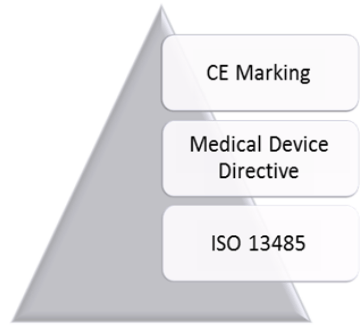 Waqas Imam
Waqas Imam
October 12, 2017
The CE marking is a gateway to marketing products in Europe, even if the medical device was produced somewhere other than the European Union. It is the producer’s mandatory obligation to acquire and display the CE mark on the device before marketing it in the European Economic Area (EEA). If the medical device is imported from outside the EEA, then this obligation transfers to the importer. The term “CE” is the short form of the French phrase “Conformité Européene,” which translates to “European Conformity” in English.
ISO 13485 is aligned with European medical device directives; therefore, its implementation helps to fulfill the requirements of these directives. Three different directives are applicable to different types of medical devices in Europe. Both the Medical Device Directive (93/42/EEC) and the Active Implantable Medical Devices Directive (90/385/EEC) have been modified by a new directive (2007/47/CE). The third directive is the In Vitro Diagnostics Directive (98/79/EC).

There are some logical and procedural steps to getting the CE marking on your device. The “old method” required the fulfillment of exceedingly thorough technical conditions. The “new method” comprises more reasonable and uniform requirements for safety and functionality, and the following steps will be helpful as you work through it:
2) Recognize regulatory requirements and their fulfillment: After the identification of medical device status, a medical device supplier or producer has to recognize the requirements of applicable EU directives and fulfill them accordingly. Some of the main areas where these requirements concentrate include:
By demonstrating compliance in these areas, the manufacturer proves that the product is safe and is effective for its intended application. ISO 13485 helps suppliers to achieve requirements in these areas.
3) Development and preservation of the technical files: This is also known as the technical documentation of a medical device. It comprises evidence of every manufacturing stage that shows that the product is compliant. The technical files focuses on some common areas, such as:
With the help of technical documentation and records, the manufacturer proves not only that the product is compliant with the requirements of the European Directives, but also that all the processes and phases of the manufacturing processes have been documented. ISO 13485 helps to meet the above requirements through the management of medical device files.
4) Review for product conformity: The supplier or device manufacturer in Europe has to get review and approval for certain devices that fall into Class III (Active Implantable Medical Devices) and all devices in Classes A and B (in vitro diagnostics devices). Reviewers will assess the conformity of the manufacturer’s testing processes.
The type of review required before approval for the CE mark is determined by the classification of the medical device. These review paths involve the assessment of the following:
The selection of a review path substantially influences the scope and dynamics of the review. This is the reason why correct medical device classification is very important for suppliers and manufacturers. A Quality Management System based on ISO 13485 helps to meet most of these review routes.
5) Declaration of conformity: This is the last step in which the supplier of the medical device confirms that the device fulfills all obligations identified in the relevant directives. Moreover, it declares that the device has gone through the program of conformity assessment and is manufactured, designed, and qualified as per the technical files developed. The declaration of conformity is documented on a certificate with all declaration statements of conformity.
Because the conformity assessment routes include both design verification and validation review, an ISO 13485 Quality Management System for both products and processes can help manufacturers to have the required systems in place even before pursuing the CE mark for the European market.
Companies operating outside the European market that already have a Quality Management System founded on ISO 13485 can more easily obtain the CE mark for their products, as many of directives’ conformity assessment review requirements are already met through implementing the ISO 13485 standard. In some medical products (produced via ISO 13485-compliant systems), a certificate of declaration of conformity by the manufacturer is enough to attain a CE mark.
To learn which documents are needed to comply with EU MDR, download this free white paper: EU MDR Checklist of Mandatory Documents.